SSM(spring+springmvc+mybatis)整合
spring与SpringMvc的常用注解
一、spring常用注解:
- @Component:实现bean的注入(不过获取bean需要用bean的类型来获取(即class文件))
@controller、@Service、@Repository的作用等同于@Component注解的作用,相当于其别名,只是为了更好的区分表现层,业务层,数据层的注解,web开发,提供3个@Component注解衍生注解(功能一样)取代括号里一般不用参数- @Repository(“名称”):dao层
- @Service(“名称”):service层
- @Controller(“名称”):web层(控制层)
- @Configuration:用于设定当前类为核心配置类
- @ComponentScan注解用于设定扫描路径,此注解只能添加一次,多个数据要用数组的格式
- @Scope:定义bean的作用范围
- (@Scope(“singleton”): 单实例的(单例)(默认)
- (@Scope(“prototype”):该bean为非单例模式)
- 定义bean的生命周期:
- @ PostConstruct 自定义初始化(构造方法后)
- @ PreDestroy 自定义销毁(销毁前)
- @Autowired:自动根据类型进行装配
- @Qualifier:指定自动注入的bean的名称(需要和@Autowired集合使用)
- @Value:实现简单类型注入
- @PropertySource:加载properties文件(其路径仅支持单一文件配置,多文件请使用数组格式配置,不允许使用通配符*)
- @Bean:表示当前方法的返回值是一个bean(配置第三方bean,使用在方法上)
- @Import:将某个类配置到配置类的核心配置,此注解只能添加一次,多个数据请用数组格式
二、测试类的注解:
- @RunWith():设定类运行器。(@RunWith(SpringJUnit4ClassRunner.class))
- @ContextConfiguration():告诉测试类环境的配置(@ContextConfiguration(classes = SpringConfig.class))
- SpringConfig.class是spring核心配置类
三、事务方面的注解:
- @Transactional:代表开始事务,通常不写在实现类上,而是写到接口上
- 在Service中,被 @Transactional 注解的方法,将支持事务。如果注解在类上,则整个类的所有方法都默认支持事务
- @EnableTransactionManagement:事务总开关,即开启注解事务管理(放在SpringConfig类上方)
四、springMVC注解:
- @RequestMapping:是一个用来处理请求地址映射的注解,可用于映射一个请求或一个方法,可以用在类或方法上
- @ResponseBody:
- 2.1 设置当前操作的返回值类型(设置当前控制器方法响应内容为当前返回值,无需解析)
- 2.2 设置当前控制器返回值作为响应体
- @RequestParam:当请求参数名和形参参数名不一样的时候,可以使用@RequestParam()绑定请求参数和形参的关系。
- @RequestBody:将前端发送的请求中的请求体所包含的数据传递给请求参数,此注解一个处理器方法(其实就是方法)只能使用一次(传递json数据时使用)
- @EnableWebMvc:开启SpringMVC多项辅助功能(开启自动转化json数据的支持(就是说,前端传过来的json数据自动转换为实体类的对象),放在SpringMvcConfig上方)
- @PathVariable:绑定路径参数与处理器方法形参之间的关系,要求路径参数名与形参名一一对应。
- @RestControllerAdvice用于标识当前类为REST风格对应的异常处理器
- @ExceptionHandler类型:设置指定异常的处理方案,功能等同于控制器方法,出现异常后终止原始控制器执行,并转入当前方法执行。
五、REST风格注解:
- @RestController:设置当前控制器类为RESTful风格,等同于@Controller与ResponseBody两个注解组合功能
- @GetMapping:查询,贴在请求映射方法上,等价于:@RequestMapping(method = RequestMethod.GET)
- @PostMapping:新增/保存,贴在请求映射方法上,等价于:@RequestMapping(method = RequestMethod.POST)
- @PutMapping:修改/更新,贴在请求映射方法上,等价于:@RequestMapping(method = RequestMethod.PUT)
- @DeleteMapping:删除,贴在请求映射方法上,等价于:@RequestMapping(method = RequestMethod.DELETE)
ssm整合(注解式)
整合流程
- 创建工程
- 创建一个maven工程
- 在pom.xml文件中导入对应的依赖
- 添加web框架------------------------------------》如何添加web框架
- ssm的配置的整合(使用配置类代替原始的配置文件操作)
- spring
- SpringConfig(spring的核心配置类)
- Mybatis
- MybatisConfig(mybatis的配置类)
- JdbcConfig(jdbc的数据处理类)
- jdbc.properties(数据库的配置文件,数据库连接四要素)
- SpringMvC
- ServletConfig(Web项目入口配置类)
- SpringMvcConfig(SpringMVC的核心配置类)
- spring
- 功能的实现
- 实体类
- 整合类(Result)
- mapper层(接口+自动代理)
- service(接口+实现类)
- controller(表现层)
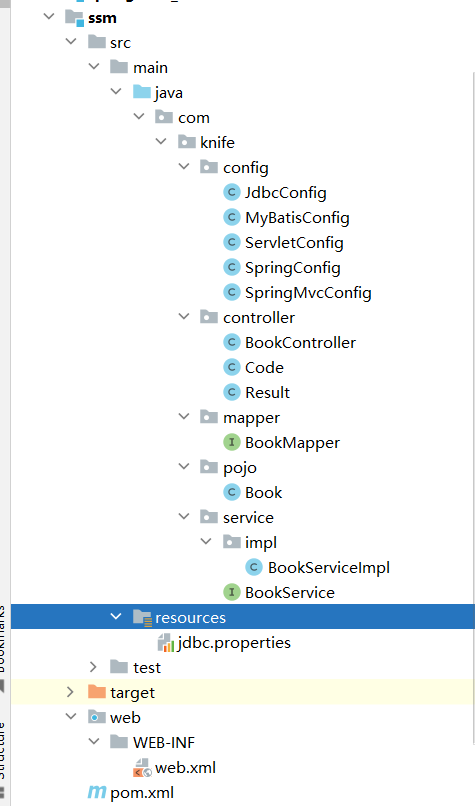
配置类
一、添加依赖
注意:记得设置项目的打包方式:war
<?xml version="1.0" encoding="UTF-8"?>
<project xmlns="http://maven.apache.org/POM/4.0.0"
xmlns:xsi="http://www.w3.org/2001/XMLSchema-instance"
xsi:schemaLocation="http://maven.apache.org/POM/4.0.0 http://maven.apache.org/xsd/maven-4.0.0.xsd">
<modelVersion>4.0.0</modelVersion>
<groupId>com.knife</groupId>
<artifactId>ssm</artifactId>
<version>1.0-SNAPSHOT</version>
<packaging>war</packaging>
<properties>
<maven.compiler.source>8</maven.compiler.source>
<maven.compiler.target>8</maven.compiler.target>
<project.build.sourceEncoding>UTF-8</project.build.sourceEncoding>
</properties>
<dependencies>
<!-- 这个依赖包含Spring MVC框架相关的所有类。-->
<!--spring-context依赖为Spring核心提供了大量扩展。可以找到使用Spring ApplicationContext特性时所需的全部类-->
<dependency>
<groupId>org.springframework</groupId>
<artifactId>spring-webmvc</artifactId>
<version>5.2.10.RELEASE</version>
</dependency>
<!-- 基于spring测试所使用的依赖-->
<dependency>
<groupId>org.springframework</groupId>
<artifactId>spring-test</artifactId>
<version>5.2.10.RELEASE</version>
</dependency>
<!-- 这个依赖对Spring对JDBC数据访问进行封装的所有类。-->
<dependency>
<groupId>org.springframework</groupId>
<artifactId>spring-jdbc</artifactId>
<version>5.2.10.RELEASE</version>
</dependency>
<dependency>
<groupId>org.mybatis</groupId>
<artifactId>mybatis</artifactId>
<version>3.5.6</version>
</dependency>
<dependency>
<groupId>org.mybatis</groupId>
<artifactId>mybatis-spring</artifactId>
<version>1.3.0</version>
</dependency>
<dependency>
<groupId>mysql</groupId>
<artifactId>mysql-connector-java</artifactId>
<version>8.0.31</version>
</dependency>
<dependency>
<groupId>com.alibaba</groupId>
<artifactId>druid</artifactId>
<version>1.1.16</version>
</dependency>
<!-- -->
<dependency>
<groupId>junit</groupId>
<artifactId>junit</artifactId>
<version>4.12</version>
<scope>test</scope>
</dependency>
<dependency>
<groupId>javax.servlet</groupId>
<artifactId>javax.servlet-api</artifactId>
<version>3.1.0</version>
<scope>provided</scope>
</dependency>
<dependency>
<groupId>com.fasterxml.jackson.core</groupId>
<artifactId>jackson-databind</artifactId>
<version>2.9.0</version>
</dependency>
</dependencies>
</project>
二、按照上图创建项目包结构
- config目录存放的是相关的配置类
- controller层下放的是Controller类
- mapper层下存放的是Mapper接口,因为使用的是Mapper接口代理方式,所以没有实现类包
- pojo层下是存放实体类
- service存的是Service接口,impl存放的是Service实现类
- resources:存入的是配置文件,如Jdbc.properties
- web:目录可以存放静态资源
- test/java:存放的是测试类
三、创建JdbcConfig配置类
public class JdbcConfig {
@Value("${jdbc.driver}") //简单类型注入,即把jdbc.driver的值赋值给变量driver
private String driver;
@Value("${jdbc.url}")
private String url;
@Value("${jdbc.username}")
private String username;
@Value("${jdbc.password}")
private String password;
@Bean
public DataSource dataSource(){
DruidDataSource dataSource = new DruidDataSource();
dataSource.setDriverClassName(driver);
dataSource.setUrl(url);
dataSource.setUsername(username);
dataSource.setPassword(password);
return dataSource;
}
//配置事务管理器,mybatis使用的是jdbc事务
@Bean
public PlatformTransactionManager transactionManager(DataSource dataSource){
DataSourceTransactionManager ds = new DataSourceTransactionManager();
ds.setDataSource(dataSource);
return ds;
}
}
四、编写SpringConfig(spring的核心配置类)
@Configuration //设定当前类为**核心配置类**
@ComponentScan({"com.knife.service"})//加载他要控制的那些bean
@PropertySource("classpath:jdbc.properties") //加载properties文件
@Import({JdbcConfig.class,MyBatisConfig.class}) //将某个类配置到 配置类的核心配置
@EnableTransactionManagement//开启注解式事务驱动
public class SpringConfig {
}
五、创建MybatisConfig配置类
public class MyBatisConfig {
@Bean
public SqlSessionFactoryBean sqlSessionFactory(DataSource dataSource){
SqlSessionFactoryBean factoryBean = new SqlSessionFactoryBean();
factoryBean.setDataSource(dataSource);
factoryBean.setTypeAliasesPackage("com.knife.pojo");
return factoryBean;
}
@Bean
public MapperScannerConfigurer mapperScannerConfigurer(){
MapperScannerConfigurer msc = new MapperScannerConfigurer();
msc.setBasePackage("com.knife.mapper");
return msc;
}
}
六、创建jdbc.properties
- 在resources下提供jdbc.properties,设置数据库连接四要素
jdbc.driver=com.mysql.cj.jdbc.Driver
jdbc.url=jdbc:mysql://localhost:3306/ssm_db
jdbc.username=root
jdbc.password=dadao
七、创建SpringMVC配置类
@Configuration
@ComponentScan("com.knife.controller")
@EnableWebMvc
public class SpringMvcConfig {
}
八、创建Web项目入口配置类
public class ServletConfig extends AbstractAnnotationConfigDispatcherServletInitializer {
//加载Spring配置类
protected Class<?>[] getRootConfigClasses() {
return new Class[]{SpringConfig.class};
}
//加载SpringMVC配置类
protected Class<?>[] getServletConfigClasses() {
return new Class[]{SpringMvcConfig.class};
}
//设置SpringMVC请求地址拦截规则
// springmvc设定拦截所有的请求,把也页面的请求也给拦截了(表示所有的访问都会经过springmvc中)
protected String[] getServletMappings() {
return new String[]{"/"};
}
//设置post请求中文乱码过滤器
// 处理表单提交中文过滤器的
@Override
protected Filter[] getServletFilters() {
CharacterEncodingFilter filter = new CharacterEncodingFilter();//字符过滤器
filter.setEncoding("UTF-8");
return new Filter[]{filter};
}
}
这里springMVC被设定拦截所有的请求,自然也会拦截静态资源的请求,当我们请求静态资源的时候,所有的访问都会经过springmvc中,发现无法找到资源。
功能模块的实现
实现数据库的增删改查
数据库的创建
create database ssm_db character set utf8;
use ssm_db;
create table tbl_book(
id int primary key auto_increment,
type varchar(20),
name varchar(50),
description varchar(255)
)
insert into `tbl_book`(`id`,`type`,`name`,`description`) values (1,'计算机理论','Spring实战 第五版','Spring入门经典教程,深入理解Spring原理技术内幕'),(2,'计算机理论','Spring 5核心原理与30个类手写实践','十年沉淀之作,手写Spring精华思想'),(3,'计算机理论','Spring 5设计模式','深入Spring源码刨析Spring源码中蕴含的10大设计模式'),(4,'计算机理论','Spring MVC+Mybatis开发从入门到项目实战','全方位解析面向Web应用的轻量级框架,带你成为Spring MVC开发高手'),(5,'计算机理论','轻量级Java Web企业应用实战','源码级刨析Spring框架,适合已掌握Java基础的读者'),(6,'计算机理论','Java核心技术 卷Ⅰ 基础知识(原书第11版)','Core Java第11版,Jolt大奖获奖作品,针对Java SE9、10、11全面更新'),(7,'计算机理论','深入理解Java虚拟机','5个纬度全面刨析JVM,大厂面试知识点全覆盖'),(8,'计算机理论','Java编程思想(第4版)','Java学习必读经典,殿堂级著作!赢得了全球程序员的广泛赞誉'),(9,'计算机理论','零基础学Java(全彩版)','零基础自学编程的入门图书,由浅入深,详解Java语言的编程思想和核心技术'),(10,'市场营销','直播就这么做:主播高效沟通实战指南','李子柒、李佳奇、薇娅成长为网红的秘密都在书中'),(11,'市场营销','直播销讲实战一本通','和秋叶一起学系列网络营销书籍'),(12,'市场营销','直播带货:淘宝、天猫直播从新手到高手','一本教你如何玩转直播的书,10堂课轻松实现带货月入3W+');
实体类
public class Book {
private Integer id;
private String type;
private String name;
private String description;
@Override
public String toString() {
return "Book{" +
"id=" + id +
", type='" + type + '\'' +
", name='" + name + '\'' +
", description='" + description + '\'' +
'}';
}
public Integer getId() {
return id;
}
public void setId(Integer id) {
this.id = id;
}
public String getType() {
return type;
}
public void setType(String type) {
this.type = type;
}
public String getName() {
return name;
}
public void setName(String name) {
this.name = name;
}
public String getDescription() {
return description;
}
public void setDescription(String description) {
this.description = description;
}
}
结果封装类
封装类的实现可以参考一下这个:表现层(controller)与前端数据传输协议定义
result
package com.knife.controller;
public class Result {
private Object data;
private Integer code;
private String msg;
public Result() {
}
public Result(Integer code,Object data) {
this.data = data;
this.code = code;
}
public Result(Integer code, Object data, String msg) {
this.data = data;
this.code = code;
this.msg = msg;
}
public Object getData() {
return data;
}
public void setData(Object data) {
this.data = data;
}
public Integer getCode() {
return code;
}
public void setCode(Integer code) {
this.code = code;
}
public String getMsg() {
return msg;
}
public void setMsg(String msg) {
this.msg = msg;
}
}
code
public class Code {
public static final Integer SAVE_OK = 20011;
public static final Integer DELETE_OK = 20021;
public static final Integer UPDATE_OK = 20031;
public static final Integer GET_OK = 20041;
public static final Integer SAVE_ERR = 20010;
public static final Integer DELETE_ERR = 20020;
public static final Integer UPDATE_ERR = 20030;
public static final Integer GET_ERR = 20040;
public static final Integer SYSTEM_ERR = 50001;
public static final Integer SYSTEM_TIMEOUT_ERR = 50002;
public static final Integer SYSTEM_UNKNOW_ERR = 59999;
public static final Integer BUSINESS_ERR = 60002;
}
控制层
@RestController
@RequestMapping("/books")
public class BookController {
@Autowired
private BookService bookService;
@PostMapping
public Result save(@RequestBody Book book) {
boolean flag = bookService.save(book);
return new Result(flag ? Code.SAVE_OK:Code.SAVE_ERR,flag);
}
@PutMapping
public Result update(@RequestBody Book book) {
boolean flag = bookService.update(book);
return new Result(flag ? Code.UPDATE_OK:Code.UPDATE_ERR,flag);
}
@DeleteMapping("/{id}")
public Result delete(@PathVariable Integer id) {
boolean flag = bookService.delete(id);
return new Result(flag ? Code.DELETE_OK:Code.DELETE_ERR,flag);
}
@GetMapping("/{id}")
public Result getById(@PathVariable Integer id) {
Book book = bookService.getById(id);
Integer code = book != null ? Code.GET_OK : Code.GET_ERR;
String msg = book != null ? "" : "数据查询失败,请重试!";
return new Result(code,book,msg);
}
@GetMapping
public Result getAll() {
List<Book> bookList = bookService.getAll();
Integer code = bookList != null ? Code.GET_OK : Code.GET_ERR;
String msg = bookList != null ? "" : "数据查询失败,请重试!";
return new Result(code,bookList,msg);
}
}
业务层
业务层接口
@Transactional
public interface BookService {
/**
* 保存
* @param book
* @return
*/
public boolean save(Book book);
/**
* 修改
* @param book
* @return
*/
public boolean update(Book book);
/**
* 按id删除
* @param id
* @return
*/
public boolean delete(Integer id);
/**
* 按id查询
* @param id
* @return
*/
public Book getById(Integer id);
/**
* 查询全部
* @return
*/
public List<Book> getAll();
}
业务层
@Service
public class BookServiceImpl implements BookService {
@Autowired
private BookMapper bookMapper;//这里并不是报错,只是spring自动代理还没有加载到对应的bean
public boolean save(Book book) {
return bookMapper.save(book)>0;
}
public boolean update(Book book) {
return bookMapper.update(book) > 0;
}
public boolean delete(Integer id) {
return bookMapper.delete(id) > 0;
}
public Book getById(Integer id) {
return bookMapper.getById(id);
}
public List<Book> getAll() {
return bookMapper.getAll();
}
}
数据层(mapper)
public interface BookMapper {
@Insert("insert into tbl_book (type,name,description) values(#{type},#{name},#{description})")
public int save(Book book);
@Update("update tbl_book set type = #{type}, name = #{name}, description = #{description} where id = #{id}")
public int update(Book book);
@Delete("delete from tbl_book where id = #{id}")
public int delete(Integer id);
@Select("select * from tbl_book where id = #{id}")
public Book getById(Integer id);
@Select("select * from tbl_book")
public List<Book> getAll();
}
到这里ssm的整合就算基本完成了,只是单纯后端的实现,并没有使用到前端。
单元测试
对于业务层的测试:Spring整合Junit的知识点进行单元测试:其实和普通的单元测试差别就在于使用了@RunWith(SpringJUnit4ClassRunner.class)
@ContextConfiguration(classes = SpringConfig.class)两个注解,这样测试的时候会通过spring内部。
@RunWith(SpringJUnit4ClassRunner.class)
@ContextConfiguration(classes = SpringConfig.class)
public class BookServiceTest {
// 业务层对象,通过 @Autowired自动注入
@Autowired
private BookService bookService;
@Test
public void testGetById(){
Book book = bookService.getById(1);
System.out.println(book);
}
@Test
public void testGetAll(){
List<Book> all = bookService.getAll();
System.out.println(all);
}
}
对于控制层的测试:使用postman测试即可(实在不行可以直接搜索每个方法对应的访问路径)。
查询全部的测试:直接输入路径然后访问

对异常进行统一处理
-
异常的种类及出现异常的原因:
- 框架内部抛出的异常:因使用不合规导致
- 数据层抛出的异常:因外部服务器故障导致(例如:服务器访问超时)
- 业务层抛出的异常:因业务逻辑书写错误导致(例如:遍历业务书写操作,导致索引异常等)
- 表现层抛出的异常:因数据收集、校验等规则导致(例如:不匹配的数据类型间导致异常)
- 工具类抛出的异常:因工具类书写不严谨不够健壮导致(例如:必要释放的连接长期未释放等)
-
思考问题:
-
- 各个层级均出现异常,异常处理代码书写在哪一层?
- 所有的异常均抛出到表现层进行处理
-
- 异常的种类很多,表现层如何将所有的异常都处理到呢?
- 异常分类
-
- 表现层处理异常,每个方法中单独书写,代码书写量巨大且意义不强,如何解决?
- AOP
-
-
问题解决:
- 使用异常处理器:
- 集中的、统一的处理项目中出现的异常。
- 使用异常处理器:
异常处理器的使用
在前面的ssm整合的基础下,创建异常处理器类(可以放在controller层下,因为SpringMvcController配置类把controller层下的所有类到扫描到了@ComponentScan(“com.knife.controller”),你也可以自己创建一个异常处理器包,然后把包的路径添加到@ComponentScan里确保SpringMvcConfig能够扫描到异常处理器类。
//@RestControllerAdvice用于标识当前类为REST风格对应的异常处理器
@RestControllerAdvice
public class ProjectExceptionAdvice {
//除了自定义的异常处理器,保留对Exception类型的异常处理,用于处理非预期的异常
@ExceptionHandler(Exception.class)
public void doException(Exception ex){
System.out.println("嘿嘿,异常你哪里跑!")
}
}
使用之后,如果项目出现异常就会跑到异常处理器里面,执行里面对应的方法。
异常分类
- 因为异常的种类有很多,如果每一个异常都对应一个@ExceptionHandler,那得写多少个方法来处理各自的异常,所以我们在处理异常之前,需要对异常进行一个分类:
- 一、业务异常(BusinessException)
-
- 规范的用户行为产生的异常
- 例子:用户在页面输入内容的时候未按照指定格式进行数据填写,如在年龄框输入的是字符串
-
- 不规范的用户行为操作产生的异常
- 例子:如用户故意传递错误数据
-
- 二、系统异常(SystemException)
-
- 项目运行过程中可预计但无法避免的异常
- 例子:比如数据库或服务器宕机
-
- 三、其他异常(Exception)
- 编程人员未预期到的异常,如:用到的文件不存在
- 一、业务异常(BusinessException)
异常解决方案
- 业务异常(BusinessException)
- 发送对应消息传递给用户,提醒规范操作
- 大家常见的就是提示用户名已存在或密码格式不正确等
- 发送对应消息传递给用户,提醒规范操作
- 系统异常(SystemException)
- 发送固定消息传递给用户,安抚用户
- 系统繁忙,请稍后再试
- 系统正在维护升级,请稍后再试
- 系统出问题,请联系系统管理员等
- 发送特定消息给运维人员,提醒维护
- 可以发送短信、邮箱或者是公司内部通信软件
- 记录日志
- 发消息和记录日志对用户来说是不可见的,属于后台程序
- 发送固定消息传递给用户,安抚用户
- 其他异常(Exception)
- 发送固定消息传递给用户,安抚用户
- 发送特定消息给编程人员,提醒维护(纳入预期范围内)
- 一般是程序没有考虑全,比如未做非空校验等
- 记录日志
异常解决方案的实现
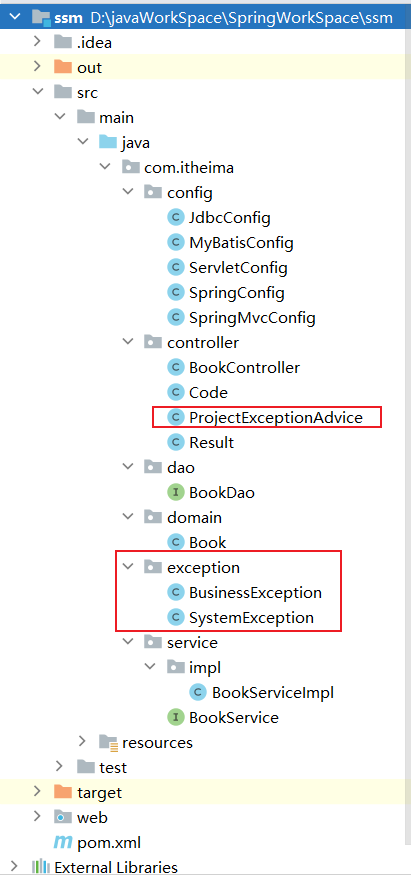
思路:
1.先通过自定义异常,完成BusinessException和SystemException的定义
2.将其他异常包装成自定义异常类型
3.在异常处理器类中对不同的异常进行处理
步骤1:自定义异常类
SystemException:
//自定义异常处理器,用于封装异常信息,对异常进行分类
public class SystemException extends RuntimeException{
private Integer code;
public Integer getCode() {
return code;
}
public void setCode(Integer code) {
this.code = code;
}
public SystemException(Integer code, String message) {
super(message);
this.code = code;
}
public SystemException(Integer code, String message, Throwable cause) {
super(message, cause);
this.code = code;
}
}
BusinessException :
//自定义异常处理器,用于封装异常信息,对异常进行分类
public class BusinessException extends RuntimeException{
private Integer code;
public Integer getCode() {
return code;
}
public void setCode(Integer code) {
this.code = code;
}
public BusinessException(Integer code, String message) {
super(message);
this.code = code;
}
public BusinessException(Integer code, String message, Throwable cause) {
super(message, cause);
this.code = code;
}
}
- 说明:
- 让自定义异常类继承
RuntimeException的好处是,后期在抛出这两个异常的时候,就不用在try…catch…或throws了 - 自定义异常类中添加
code属性的原因是为了更好的区分异常是来自哪个业务的
- 让自定义异常类继承
步骤2:将其他异常抛出的时候使用自定义异常
- 具体的包装方式有:
- 方式一:
try{}catch(){}在catch中重新throw我们自定义异常即可。 - 方式二:直接throw自定义异常即可
- 方式一:
public Book getById(Integer id) {
//方式一
//模拟业务异常,包装成自定义异常
if(id == 1){
throw new BusinessException(Code.BUSINESS_ERR,"请不要使用你的技术挑战我的耐性!");
}
// 方式二
//模拟系统异常,将可能出现的异常进行包装,转换成自定义异常
try{
int i = 1/0;
}catch (Exception e){
throw new SystemException(Code.SYSTEM_TIMEOUT_ERR,"服务器访问超时,请重试!",e);
}
return bookDao.getById(id);
}
code类需要使用到的常量,上面已经定义好了。不同的状态码代表着不同的意义,根据自己的需求设计即可。
步骤3:在异常处理器类中处理自定义异常
//@RestControllerAdvice用于标识当前类为REST风格对应的异常处理器
@RestControllerAdvice
public class ProjectExceptionAdvice {
//@ExceptionHandler用于设置当前处理器类对应的异常类型
@ExceptionHandler(SystemException.class)
public Result doSystemException(SystemException ex){
//记录日志
//发送消息给运维
//发送邮件给开发人员,ex对象发送给开发人员
return new Result(ex.getCode(),null,ex.getMessage());
}
@ExceptionHandler(BusinessException.class)
public Result doBusinessException(BusinessException ex){
return new Result(ex.getCode(),null,ex.getMessage());
}
//除了自定义的异常处理器,保留对Exception类型的异常处理,用于处理非预期的异常
@ExceptionHandler(Exception.class)
public Result doOtherException(Exception ex){
//记录日志
//发送消息给运维
//发送邮件给开发人员,ex对象发送给开发人员
return new Result(Code.SYSTEM_UNKNOW_ERR,null,"系统繁忙,请稍后再试!");
}
}
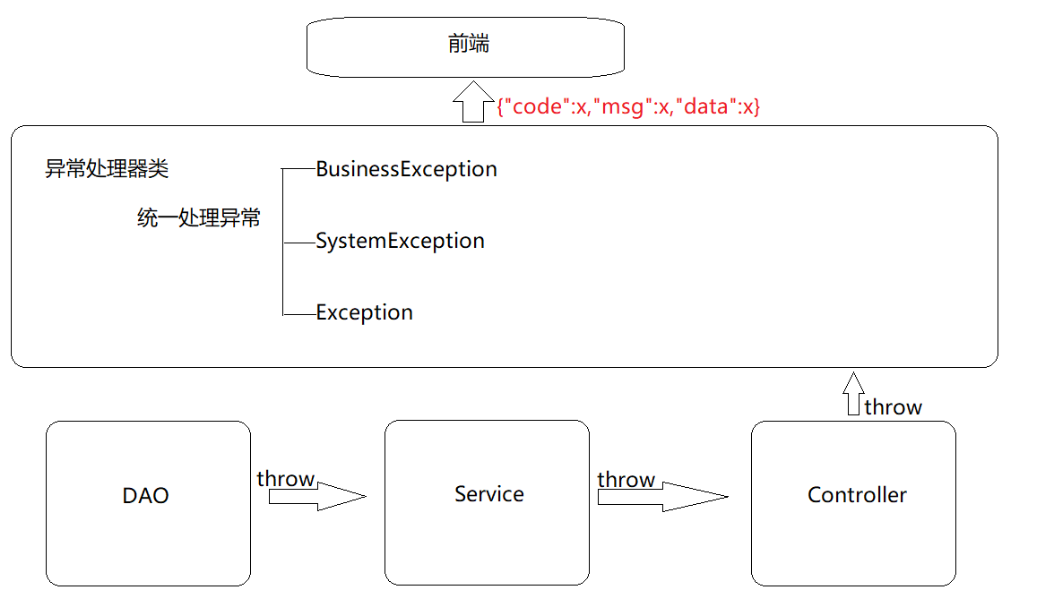
前后台协议联调
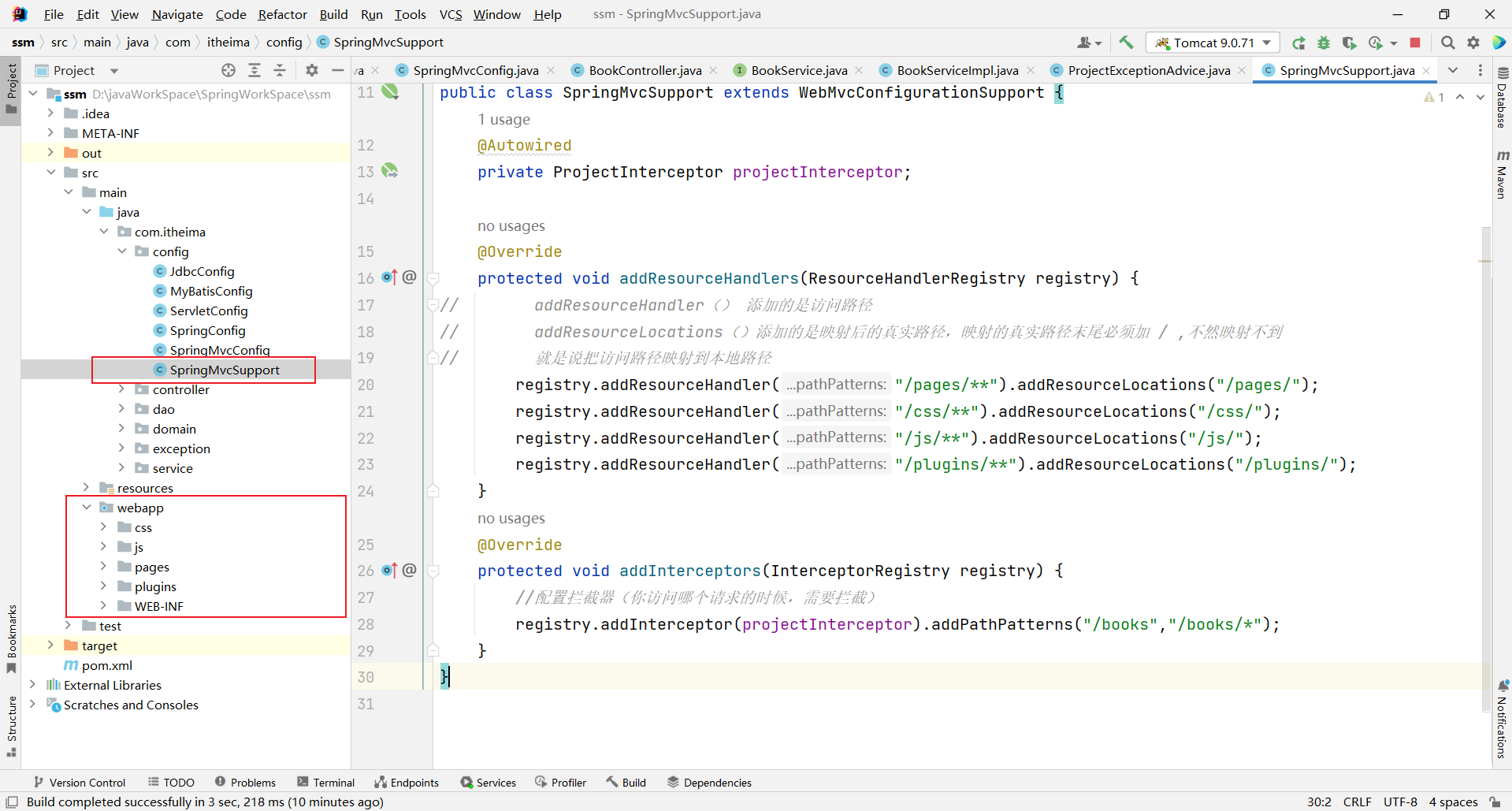
配置静态资源访问映射:
@Configuration
public class SpringMvcSupport extends WebMvcConfigurationSupport {
@Override
protected void addResourceHandlers(ResourceHandlerRegistry registry) {
// addResourceHandler() 添加的是访问路径
// addResourceLocations()添加的是映射后的真实路径,映射的真实路径末尾必须加 / ,不然映射不到
// 就是说把访问路径映射到本地路径
registry.addResourceHandler("/pages/**").addResourceLocations("/pages/");
registry.addResourceHandler("/css/**").addResourceLocations("/css/");
registry.addResourceHandler("/js/**").addResourceLocations("/js/");
registry.addResourceHandler("/plugins/**").addResourceLocations("/plugins/");
}
}
在SpringMvcConfig中扫描SpringMvcSupport
@Configuration
@ComponentScan({"com.itheima.controller","com.itheima.config"})
@EnableWebMvc
public class SpringMvcConfig {
}
addResourceHandlers方法(配置静态资源处理)
addResourceHandlers方法(配置静态资源处理)是SpringMVC框架提供的一种配置静态资源的方式。它可以将指定的资源路径映射到一个或多个URL路径上,并指定资源的缓存策略、版本号以及是否允许目录列表等选项。
具体使用方法如下:
@Configuration
@EnableWebMvc
public class WebConfig implements WebMvcConfigurer {
@Override
public void addResourceHandlers(ResourceHandlerRegistry registry) {
registry.addResourceHandler("/static/**")
.addResourceLocations("classpath:/static/")
.setCacheControl(CacheControl.maxAge(1, TimeUnit.HOURS))
.resourceChain(true)
.addResolver(new VersionResourceResolver().addContentVersionStrategy("/**"));
}
}
上述代码中,我们创建了一个WebConfig类,并实现了WebMvcConfigurer接口。在该类中,我们重写了addResourceHandlers方法,并在其中进行了静态资源的配置。
在addResourceHandlers方法中,我们通过registry对象调用addResourceHandler方法来添加一个处理器。在这个方法中,我们可以指定资源的URL路径,例如/static/**,表示所有以/static/开头的URL路径都会被映射到静态资源上。
接着,我们使用addResourceLocations方法指定了静态资源的位置,这里我们使用了classpath:/static/,表示静态资源位于项目的classpath下的static目录。
然后,我们使用setCacheControl方法设置了资源的缓存策略,这里我们设置了缓存时间为1小时。
接下来,我们使用resourceChain方法开启了资源链,这样可以支持版本号的处理。
最后,我们使用addResolver方法添加了一个资源解析器,这里我们使用了VersionResourceResolver,并通过addContentVersionStrategy方法指定了版本号的策略。
通过以上配置,我们可以将静态资源映射到指定的URL路径上,并进行缓存策略和版本号的配置。
拦截器(追加功能)
拦截器的概念

-
上图讲解:
- (1)浏览器发送一个请求会先到Tomcat的web服务器
- (2)Tomcat服务器接收到请求以后,会去判断请求的是静态资源还是动态资源
- (3)如果是静态资源,会直接到Tomcat的项目部署目录下去直接访问
- (4)如果是动态资源,就需要交给项目的后台代码进行处理
- (5)在找到具体的方法之前,我们可以去配置过滤器(可以配置多个),按照顺序进行执行
- (6)然后进入到到中央处理器(SpringMVC中的内容),SpringMVC会根据配置的规则进行拦截
- (7)如果满足规则,则进行处理,找到其对应的controller类中的方法进行执行,完成后返回结果
- (8)如果不满足规则,则不进行处理
-
需求:需要在每个Controller方法执行的前后添加业务
- 实现:使用拦截器
-
拦截器(Interceptor)是一种动态拦截方法调用的机制,在SpringMVC中动态拦截控制器方法的执行
- 作用:
- 在指定的方法调用前后执行预先设定的代码
- 阻止原始方法的执行
- 作用:
-
总结:拦截器就是用来做增强
-
拦截器和过滤器在作用和执行顺序上也很相似
- 所以这个时候,就有一个问题需要思考:拦截器和过滤器之间的区别是什么?
- 归属不同:Filter属于Servlet技术,Interceptor属于SpringMVC技术
- 拦截内容不同:Filter对所有访问进行增强,Interceptor仅针对SpringMVC的访问进行增强
- 所以这个时候,就有一个问题需要思考:拦截器和过滤器之间的区别是什么?
拦截器的开发(在ssm整合基础上添加拦截器)
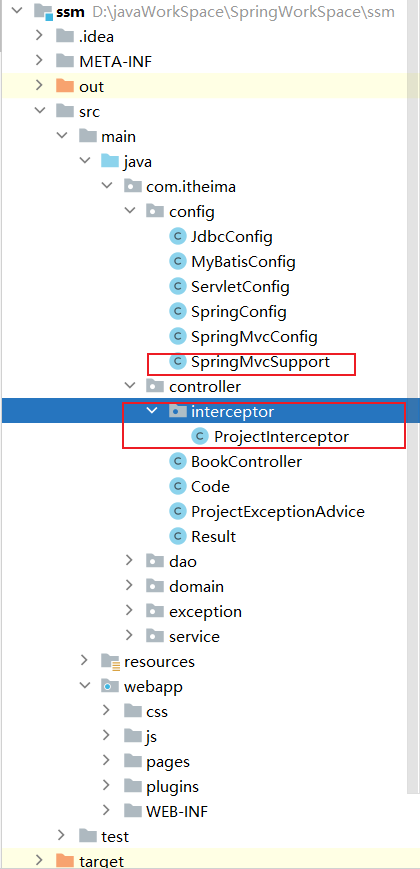
- 步骤:
-
- 创建拦截器类
-
- 配置拦截器
-
- SpringMVC添加SpringMvcSupport包扫描
-
步骤1:创建拦截器类:(可以创建多个拦截器类,然后在配置的时候使用。)
@Component
//定义拦截器类,实现HandlerInterceptor接口
//注意当前类必须受Spring容器控制
public class ProjectInterceptor implements HandlerInterceptor {
@Override
//原始方法调用前执行的内容
//返回值类型可以拦截控制的执行,true放行,false终止
// 前置方法
public boolean preHandle(HttpServletRequest request, HttpServletResponse response, Object handler) throws Exception {
String contentType = request.getHeader("Content-Type");
HandlerMethod hm = (HandlerMethod)handler;
System.out.println("preHandle..."+contentType);
return true;
//用false可以终止原始操作的运行,拦截器中的`preHandler`方法,
// 如果返回true,则代表放行,会执行原始Controller类中要请求的方法,
// 如果返回false,则代表拦截,后面的就不会再执行了。
// 请求参数说明:
// * request:请求对象:使用request对象可以获取请求数据中的内容,如获取请求头的`Content-Type`
// * response:响应对象:使用handler参数,可以获取方法的相关信息
// * handler:被调用的处理器对象,本质上是一个方法对象,对反射中的Method对象进行了再包装
}
@Override
//原始方法调用后执行的内容
// 后置方法
public void postHandle(HttpServletRequest request, HttpServletResponse response, Object handler, ModelAndView modelAndView) throws Exception {
System.out.println("postHandle...");
}
@Override
//原始方法调用完成后执行的内容
// 完成后方法
public void afterCompletion(HttpServletRequest request, HttpServletResponse response, Object handler, Exception ex) throws Exception {
System.out.println("afterCompletion...");
// ex:如果处理器执行过程中出现异常对象,可以针对异常情况进行单独处理
//
// 因为现在已经有全局异常处理器类,所以该参数的使用率也不高。
}
}
注意:拦截器类要被SpringMVC容器扫描到。
步骤2:配置拦截器:
@Configuration
public class SpringMvcSupport extends WebMvcConfigurationSupport {
@Autowired
private ProjectInterceptor projectInterceptor;
@Override
protected void addResourceHandlers(ResourceHandlerRegistry registry) {
// addResourceHandler() 添加的是访问路径
// addResourceLocations()添加的是映射后的真实路径,映射的真实路径末尾必须加 / ,不然映射不到
// 就是说把访问路径映射到本地路径
registry.addResourceHandler("/pages/**").addResourceLocations("/pages/");
registry.addResourceHandler("/css/**").addResourceLocations("/css/");
registry.addResourceHandler("/js/**").addResourceLocations("/js/");
registry.addResourceHandler("/plugins/**").addResourceLocations("/plugins/");
}
@Override
protected void addInterceptors(InterceptorRegistry registry) {
//配置拦截器(你访问哪个请求的时候,需要拦截)
registry.addInterceptor(projectInterceptor).addPathPatterns("/books","/books/*");
}
}
步骤3:SpringMVC添加SpringMvcSupport包扫描
@Configuration
@ComponentScan({"com.itheima.controller","com.itheima.config"})
@EnableWebMvc
public class SpringMvcConfig{
}

本文来自互联网用户投稿,该文观点仅代表作者本人,不代表本站立场。本站仅提供信息存储空间服务,不拥有所有权,不承担相关法律责任。 如若内容造成侵权/违法违规/事实不符,请联系我的编程经验分享网邮箱:veading@qq.com进行投诉反馈,一经查实,立即删除!